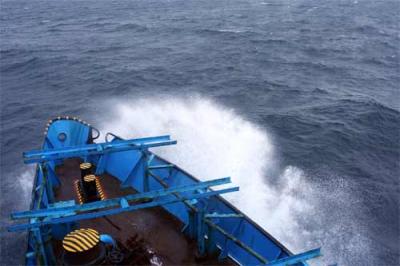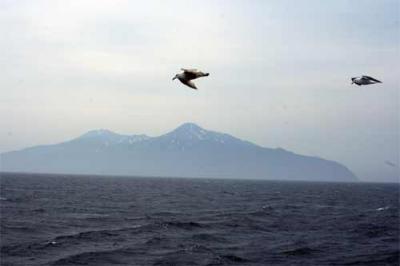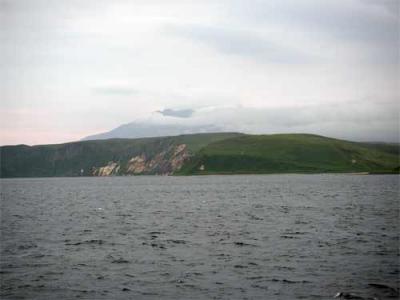It took 42 hours to get from Bellingham to Yuzhno-Sakhalinsk. We spent 113 hours in Yuzhno-Sakhalinsk. And now we have completed a 62 hour total journey from Yuzhno-Sakhalinsk to our first destination in the Kuril Islands. We left Korsakov at about 5:20 pm on July 18 and last night at 11:30 pm on July 20 we anchored off the southwestern shore of Urup Island, near a site called Ainu Creek.
It was a fairly uneventful crossing – at least from MY perspective….which has primarily been a view of the underside of the upper bunk and the inside of my cabin!
The crossing wasn’t tremendously rough – we didn’t have the 9 meter swells that they were rumored to have the first time, but it hasn’t really been easy either. We had 1-2 meter swells at various times and nearly every one of us has had to spend some part of the time riding it out on our beds. With the tremendous exception, however, of Shelby, who was still as chipper and happy as ever throughout the entire journey, completely unaffected by the rocking and rolling of the ship. You go, girl!
My last two days, like many people’s, have alternated between brief periods of productivity – such as downloading and naming pictures, catching up on journals, reading a book (I just finished The Golden Compass and will work on The Subtle Knife next) – and short trips to the dining room to retrieve nourishment that are interspersed with much longer periods of recuperating – lying on your bunk, either napping or wishing that you still could nap. I usually gave up the fight by about 6 or 7 pm each night, took a couple of Tylenol PM, and slept through MOST of the night. If nothing else, I am caught up now on my sleep….but my stomach would now like to be caught up too!
**Bow waves on the Iskatel **
 Waves splash over the starboard bow pontoon as the Iskatel travels through the Sea of Okhotsk on its way to the Kuril Islands. (Photo courtesy of Mike Etnier)
Waves splash over the starboard bow pontoon as the Iskatel travels through the Sea of Okhotsk on its way to the Kuril Islands. (Photo courtesy of Mike Etnier)
At about noon yesterday, we reached the somewhat calmer waters near Iturup – the larger islands provide a bit of a lee from the rougher Pacific Ocean currents. At that point we rounded the peninsula with a volcano called Chirip and entered a fairly large sheltered bay at the northern end of Iturup between two peninsulas. At that point, we slowed down even further and slowly moved up the eastern coast of the northern tip of Iturup.
Seagulls and Chirip Volcano
 Seagulls flying alongside the Iskatel as we pass Chirip volcano, located on
the northeastern end of Iturup Island. (Photo courtesy of Mike Etnier)
Seagulls flying alongside the Iskatel as we pass Chirip volcano, located on
the northeastern end of Iturup Island. (Photo courtesy of Mike Etnier)
Last night at about dinner time (unfortunately for my stomach, that meant another missed meal) we started through the channel between Iturup and Urup. It was not as rough as expected – certainly not as rough as some of the swell that we encountered out in the Sea of Okhotsk. I awoke last night briefly at about 11:30 pm to a very smooth moving ship and then very shortly after heard the engines reverse to slow us down and then they dropped the anchors.
**Struve Volcano on Urup Island **
 A view of Urup Island near Ainu Creek. In the background,
partially obscured by clouds, is Struve Volcano, which stands at 1320 meters.
A view of Urup Island near Ainu Creek. In the background,
partially obscured by clouds, is Struve Volcano, which stands at 1320 meters.
This morning, the water is fairly calm, there is a bit of wind and the sky is overcast, which makes it somewhat chilly outside, but everyone is up and about, eating a hearty breakfast and making ready to go ashore if needed. There are dig kits and day packs to prepare in case we are needed to go ashore to help finish up the excavation. Valery Shubin, from the Sakhalin Regional Museum, Matt Walsh, from our group, and several other Russian archaeologists working on Shubin’s team have been working here at Ainu Creek for about two weeks. Even if we are not needed to go ashore to help finish the excavation, there is still quite a bit of gear that will need to be loaded onto the zodiac and brought aboard on several trips. It is also quite possible that the satellite phone that Ben and I will be using will come onboard and then I will be relegated to sitting on the top deck waiting for a satellite signal so that I can phone in an update and possibly even send this backlog of journals and pictures.
Ah! We begin to practice what we experienced many times last year in the field: "We don’t know exactly what the plan is for the day, so best to get ready for a range of possibilities and then wait”. That’s part of what makes field work so interesting! You never know what might happen!
Da Svidanya! Misty

